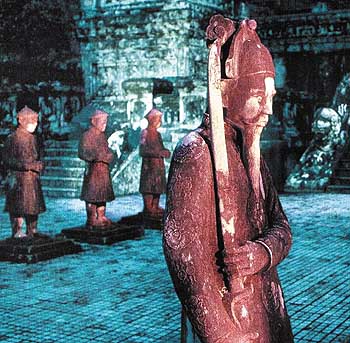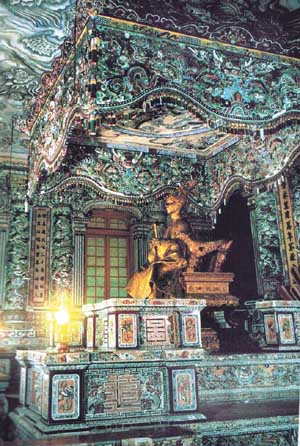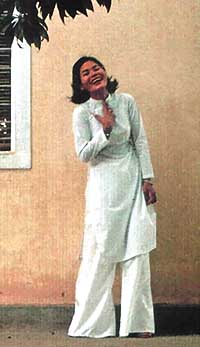by Chalerm Raksanti
A phrase of an old Vietnamese folk song translates to;
“wherever I go, I always miss Hue, I miss the cool breeze on the River
of Perfumes, I miss the clear moon over the Imperial Mountain”. After
decades of war and the legacy of grinding poverty, does that once great
city still bear any resemblance to the praises sung long ago. To the
visitor’s delight, most monuments and palaces in Doi Noi, the ‘great
interior’ of Hue are in recognisable condition. The imperial capital
built in the 19th century by the founding emperors
of the Nguyen Dynasty preserves its alluring beauty and its architectural
poetry.
 Stone
mandarins guard over the tomb of Nguyen Emperor Khai Dinh.
Stone
mandarins guard over the tomb of Nguyen Emperor Khai Dinh.
To its people, Hue is a poem, but it began in a legend.
In 1601 Lord Nguyen Hoang, father of the Nguyen Dynasty, visited a rude
village on a site now occupied by the Citadel. There, on a hill shaped
like a dragon head, a peasant had seen a lady dressed in a red gown and
green trousers. She prophesied that soon a true king would come there to
build a pagoda that will attract and converge al the heavenly forces and
energy of the Long Mach - Dragon Veins. And with that, she
vanished. Lord Nguyen built the pagoda on the hill and named it Thien Mu
(Heavenly Lady).
 Burning
incense pays tribute to the guardian of the temple in the Citadel.
Burning
incense pays tribute to the guardian of the temple in the Citadel.
Hue’s famous Quoc Hoc (National Studies School)
seethes with underground politics and ‘above ground’ literature and
arts. Writers, poets, teachers, and students flock to bookstores and
coffee and tea houses to discuss the latest issues in government policies
and social changes. In the cool of the evening as the day winds down, they
gather again for a cold beer or a pernod. Garbed in the traditional ao
dai, young Vietnamese women seem to epitomise the charm and grace of
Hue.
The 30-acre necropolis of poet emperor Tu Doc holds the
emperor’s tomb filled with porcelain and glass, and a bronze likeness.
To insure eternal harmony, Nguyen kings oriented their tombs precisely
amid pine and bamboo cloaked hills. The setting is deteriorating from a
lack of resourses to preserve the monuments from the torrential monsoon
rains and tile cracking vegetation. Nonetheless, this quiet park of
eternal rest is serene. Buddhists visit Hue’s 60 pagodas regularly for
prayer and celebration.
 Young
Vietnamese woman in her graceful national dress, the ao dai.
Young
Vietnamese woman in her graceful national dress, the ao dai.
Early dawn over Hue reveals a sleeping city. Pale light
casts a glint on the shadowy blue Imperial Screen Mountain. On the inky
surface of the River of Perfumes one sees a hard working fisherman going
out for his first catch of the day. All things seem possible in Hue.
Optimism is a tradition here. Hue has pride in its past, and delight in
its possibilities. In Vietnam, a person lives, works, suffers, succeeds,
and sacrifices. But not only for the self, but for the home, the family
(immediate and ancestral), for the yet unborn, for the village and the
nation. These unbreakable strands are the web of relations that define
one’s place in society.
On my last day in Hue I visited the tomb of Nguyen
Emperor Khai Dinh. Stone mandarins guard the tomb. In 1802 the Nguyens
unseated their rivals in Hanoi and established court at Hue. Attended by
the country’s best musicians, astrologers, chefs and physicians, they
refined cultural traditions that continue, despite the abdication of Khai
Dinh’s son, Bao Dai to Ho Chi Minh in 1945. I felt the stone mandarins
watching me with dead eyes. I waited for the ‘heavenly forces and
energies’ of the Long March, which the ghostly woman had prophesied so
long ago. A brisk wind whipped around me; then the heavens opened up and
torrents of rain drove me to cover. Just for a moment, I though I heard a
woman’s laugh.

 Stone
mandarins guard over the tomb of Nguyen Emperor Khai Dinh.
Stone
mandarins guard over the tomb of Nguyen Emperor Khai Dinh. Burning
incense pays tribute to the guardian of the temple in the Citadel.
Burning
incense pays tribute to the guardian of the temple in the Citadel. Young
Vietnamese woman in her graceful national dress, the ao dai.
Young
Vietnamese woman in her graceful national dress, the ao dai.